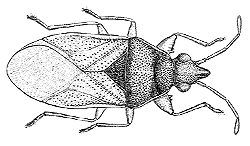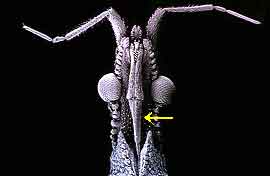|
Hemiptera:
bugs, aphids and cicadas
Characteristics
The insects
in this order are extremely diverse in their size, shape and colour.
There are about 6000 described species in Australia, ranging in
size from 1 to 110 millimetres in length. The name Hemiptera means
'half wing' and all hemipterans share the following features:
|
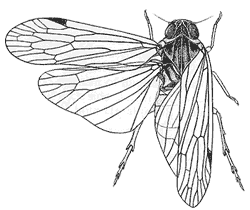
Oliarus lubra
|
|
- 2 pairs
of wings, although some species may be wingless and others have
only forewings. Wings are generally membranous
but in some species the forewings may be hardened at the base
- Piercing
or sucking mouthparts appearing as a sharply pointed tube known
as a proboscis
or rostrum,
which extends from the underside of the head
- Antennae
vary and may be either short, or long and conspicuous
The young of
hemipterans look like small adults. Some bugs may be mistaken for
beetles but can be distinguished by their mouthparts as beetles
have mandibulate
mouthparts while bugs have sucking/piercing
mouthparts.
This order is
divided into 3 suborders; true bugs (Heteroptera); hoppers (Auchenorrhyncha)
and; aphids, scale insects, lerps and mealy bugs (Sternorrhyncha).
|
|
Heteroptera
The true bugs have forewings that are hardened at the base
and membranous
at the tips. They sit flat over the abdomen hiding the membranous
hind wings. The head and proboscis
can flex forward.
|
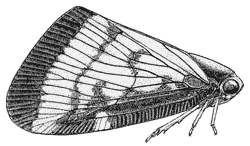 |
Auchenorrhyncha
The hoppers
have forewings that are uniform in texture and are held like
a tent over the abdomen. The head and proboscis
point down and back.
|
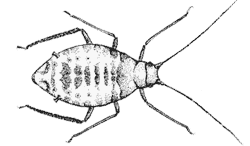 |
Sternorrhyncha
Aphids, scale, lerps and mealy bugs usually have soft bodies
and most species are wingless. Their heads and proboscis'
point down and back. They often cover themselves with wax
or froth which prevents their soft bodies from drying out.
|
Life Cycle
Hemipterans
develop by incomplete
metamorphosis and young (or nymphs)
generally resemble small, wingless adults in general structure although
their colour and markings may be very different. In some species
such as cicadas, the nymphs
who are specialised for burrowing appear quite different from the
adults. Nymphs
will moult 6 to 8 times depending on the species before they attain
maturity.
 Hemiptera
life cycle
Hemiptera
life cycle |
Feeding
Most species
of Hemiptera are plant feeders, sucking sap with many causing considerable
damage to crops, ornamental garden plants such as roses, shrubs
and trees. Some species are bloodsuckers of mammals and birds while
others are predators that feed on other invertebrates, including
some pest species and are therefore beneficial to man.
The proboscis
of hemipterans contains cutting blades and a two-channelled tube.
Hemipterans feed by cutting into a plant or animal and sending saliva
down one of the tubes to begin digestion. The liquid food is then
sucked up the other tube.
Habitat
Almost all hemipterans are terrestrial, although some groups of
Heteroptera such as the Gerromorpha and the Nepomorpha inhabit freshwater
habitats, living on the surface tension of the water and beneath
its surface respectively. Most plant feeding hemipterans are found
on the leaves, stems or bark of plants, some species aggregating
in enormous numbers, while others can be found living among the
roots. Some form protective waxy secretions or hard galls on the
leaves and stems of many Australian plants including Acacia and
Eucalyptus species.
|


